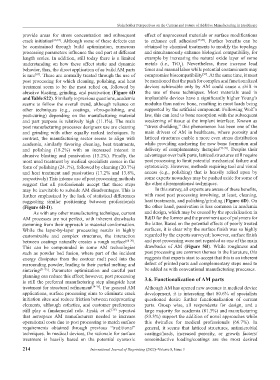Page 222 - IJB-8-3
P. 222
Stakeholder Perspectives on the Current and Future of Additive Manufacturing in Healthcare
provide areas for stress concentration and subsequent effect of unprocessed materials or surface modifications
crack initiation [66,67] . Although some of these defects can to enhance cell adhesion [27,28] . Further benefits can be
be constrained through build optimization, numerous obtained by chemical treatments to modify the topology
processing parameters influence the end part at different and simultaneously enhance biological compatibility, for
length scales. In addition, still today there is a limited example by increasing the natural oxide layer of some
understanding on how these affect static and dynamic metals (i.e., TiO ). Nevertheless, these increase lead
2
behavior, thus, the direct application of as build AM parts times and manual labor while potential contaminants may
[27]
is rare . These are normally treated through the use of compromise biocompatibility . At the same time, it must
[67]
post processing for which cleaning, polishing, and heat be mentioned that the push for complex and functionalized
treatment seem to be the most relied on, followed by devices achievable only by AM could cause a shift in
abrasive blasting, grinding, and passivation (Figure 6D the use of these techniques. Most materials used in
and Table S22). Similarly to previous questions, academia implantable devices have a significantly higher Young’s
seems to follow the overall trend, although reliance on modulus than native bone, resulting in most loads being
other techniques (e.g., coatings, vibro-polishing, and supported by the artificial component. Following Wolf’s
post-curing) depending on the manufacturing material law, this can lead to bone resorption with the subsequent
and part purpose is relatively high (11.1%). The main weakening of tissue at the implant interface. Known as
post manufacturing processes designers use are cleaning “stress shielding,” this phenomenon has been one of the
and grinding with other equally ranked techniques. In main drivers of AM in healthcare, where porosity and
contrast, the manufacturing sector seems to align with latticed structures enable a more even stress distribution
academia, similarly favoring cleaning, heat treatments, while providing anchoring for new bone formation and
and polishing (18.2%) with an increased interest in delivery of complementary therapies [77-79] . Despite their
abrasive blasting and passivation (15.2%). Finally, the advantages over bulk parts, latticed structures still require
most used treatment by medical specialists comes in the post processing to limit potential mechanical failure and
form of polishing (24.1%), followed by cleaning (20.7%) cytotoxicity. However, methods requiring tool and visual
and heat treatment and passivation (17.2% and 13.8%, access (e.g., polishing) that is heavily relied upon by
respectively) This intense use of post processing methods some experts nowadays may be pushed aside for some of
suggest that all professionals accept that these steps the other aforementioned techniques.
may be inevitable to subside AM disadvantages. This is In this survey, all experts are aware of these benefits,
further emphasized by the lack of statistical differences with most post processing involving, at least, cleaning,
suggesting similar positioning between professionals heat treatments, and polishing/grinding (Figure 6D). On
(Figure 6B-D). the other hand, passivation is less common in academia
As with any other manufacturing technique, current and design, which may be caused by the specialization in
AM processes are not perfect, with inherent drawbacks R&D for the former and the prominent use of polymers for
stemming from their approach to material conformation. the latter. Based on the potential effects of poorly treated
While the layer-by-layer processing results in highly surfaces, it is clear why the surface finish was so highly
customizable and complex structures, the interaction regarded by the experts surveyed; however, surface finish
between coatings naturally creates a rough surface [68-70] . and post processing were not regarded as one of the main
This can be compounded in some AM technologies drawbacks of AM (Figure 5B). While roughness and
such as powder bed fusion, where part of the incident post processing are common themes in the literature, this
energy dissipates from the contour melt pool into the suggests that experts start to accept that this is an inherent
surrounding powder, leading to their partial melting and defect of printed parts and complementary steps need to
sintering [71-73] . Parameter optimization and careful part be added as with conventional manufacturing processes.
planning can reduce this effect; however, post processing 3.6. Functionalization of AM parts
is still the preferred manufacturing step alongside heat
treatment for structural refinement [74-76] . For general AM Although AM has opened new avenues in medical device
applications, surface processing aims to eliminate crack development, it is interesting that 80.6% of specialists
initiation sites and reduce friction between reciprocating questioned desire further functionalization of current
elements, although esthetics, and customer preferences parts. Group wise, all respondents for design, and a
still play a fundamental role. Jirsák et al. reported large majority for academia (81.3%) and manufacturing
[36]
that aerospace AM manufacturers needed to increase (83.3%) support the addition of novel approaches while
operational costs due to post processing to match surface this dwindles for medical professionals (66.7%). In
requirements obtained through previous “traditional” general, it seems that latticed structures, antimicrobial
techniques. In medical devices, the rationale for surface coatings/loads, increased porosity, or growth factors/
treatment is heavily based on the potential cytotoxic osseoinductive loading/coatings are the most desired
214 International Journal of Bioprinting (2022)–Volume 8, Issue 3

